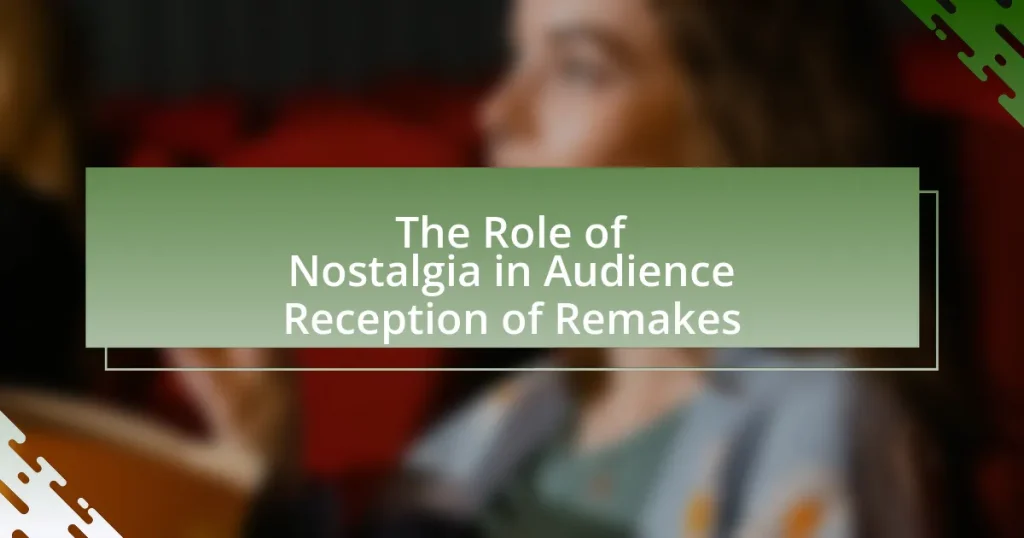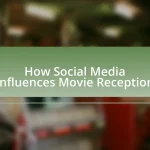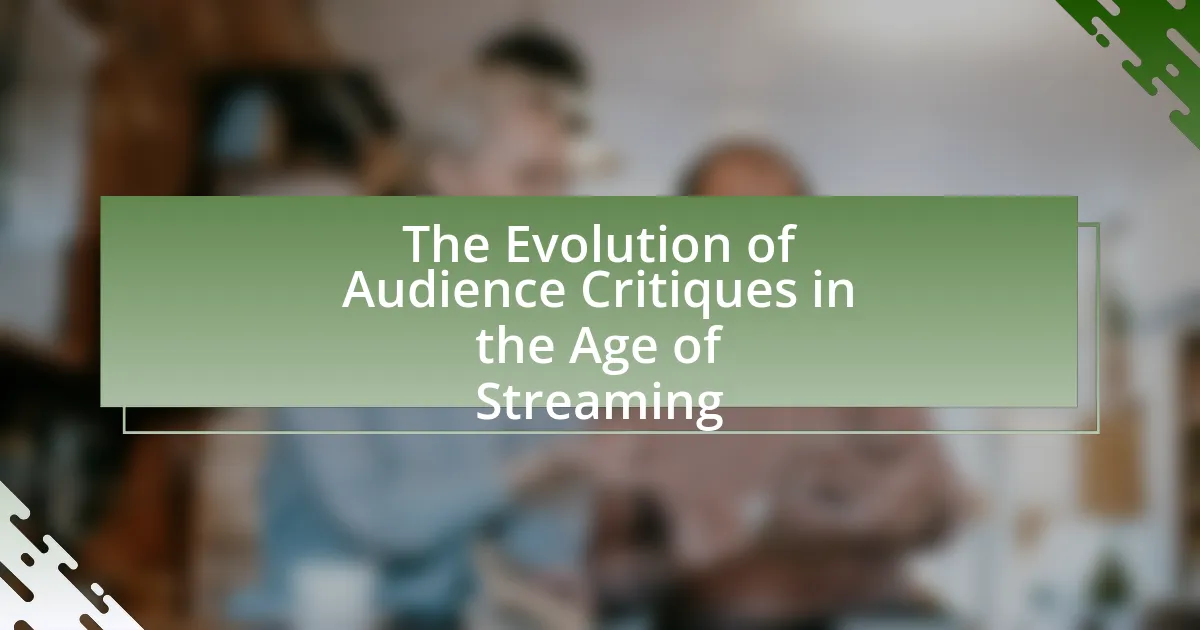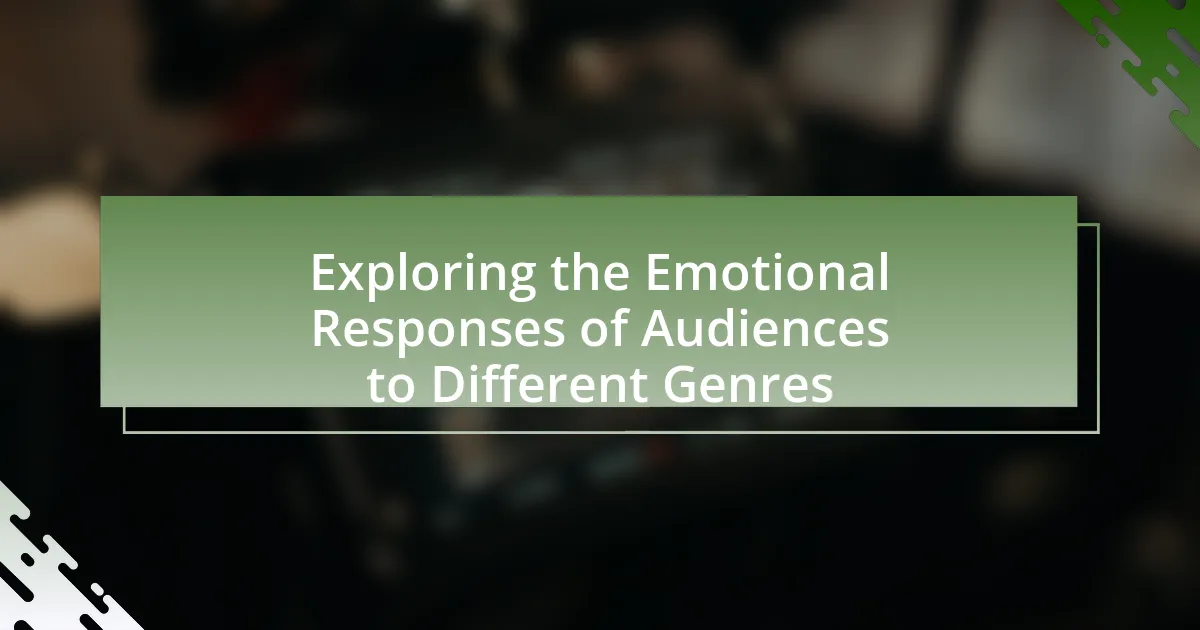The article examines the significant role of nostalgia in shaping audience reception of film remakes. It highlights how nostalgia evokes emotional connections to original works, influencing viewer engagement and satisfaction. Key aspects discussed include the psychological mechanisms behind nostalgia, its impact on audience expectations, and how filmmakers leverage nostalgic elements to enhance remakes. The article also addresses demographic factors, cultural contexts, and the balance between nostalgia and innovation, ultimately emphasizing the implications of nostalgia on both audience perception and critical reception of remakes.
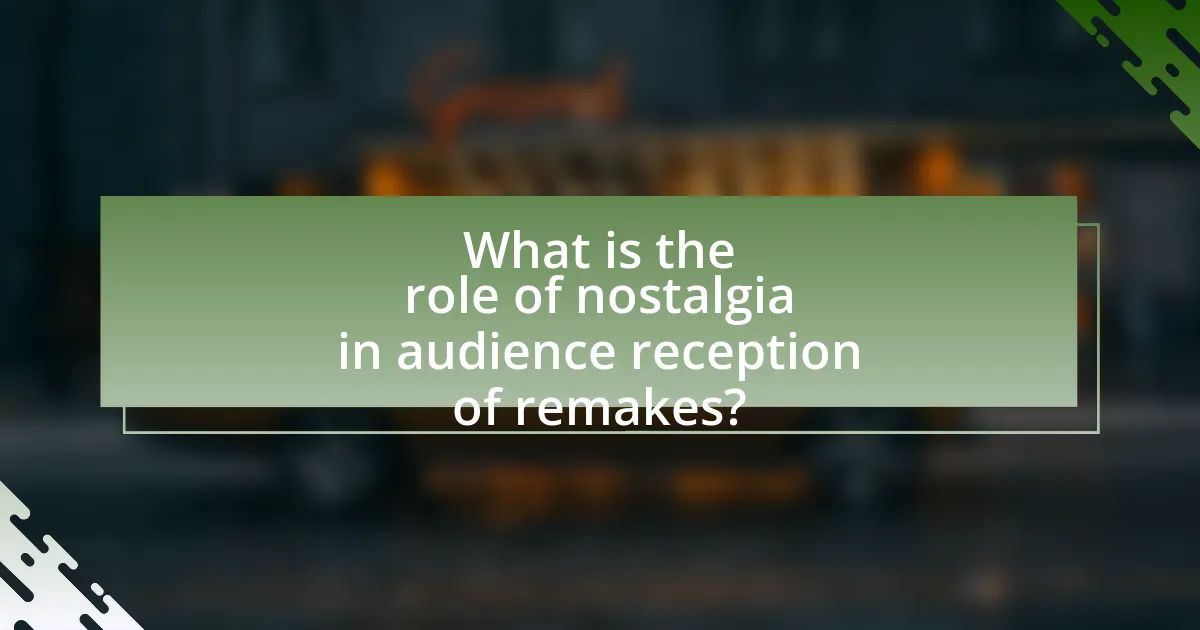
What is the role of nostalgia in audience reception of remakes?
Nostalgia plays a significant role in audience reception of remakes by evoking emotional connections to original works, which can enhance viewer engagement and satisfaction. This emotional resonance often leads audiences to approach remakes with a sense of familiarity and expectation, influencing their overall perception and enjoyment. Research indicates that nostalgia can enhance positive feelings towards remakes, as seen in studies where audiences reported greater enjoyment of films that referenced beloved elements from their childhood, such as characters or iconic scenes. For instance, a study published in the Journal of Consumer Research found that nostalgic feelings can increase consumers’ willingness to engage with and purchase products related to their past, including film remakes. Thus, nostalgia serves as a powerful tool that filmmakers can leverage to attract audiences and create a favorable reception for remakes.
How does nostalgia influence audience expectations for remakes?
Nostalgia significantly influences audience expectations for remakes by creating a longing for the original content, which shapes how viewers perceive the new version. This emotional connection often leads audiences to anticipate familiar themes, characters, and aesthetics that resonate with their memories of the original. Research indicates that nostalgia can enhance enjoyment and satisfaction, as seen in studies like “Nostalgia and Consumer Behavior” by Wildschut et al., which found that nostalgic feelings can increase positive evaluations of products, including films. Consequently, when audiences engage with remakes, they often expect them to evoke the same emotional responses and cultural significance as the originals, driving both anticipation and scrutiny of the new interpretations.
What psychological mechanisms are involved in nostalgia?
Nostalgia involves several psychological mechanisms, primarily memory recall, emotional regulation, and social connectedness. Memory recall allows individuals to access past experiences, often evoking positive emotions associated with those memories. Emotional regulation is facilitated by nostalgia, as it can enhance mood and provide comfort during times of distress. Additionally, nostalgia fosters social connectedness by reinforcing a sense of belonging and shared identity through collective memories. Research by Batcho (1995) indicates that nostalgic feelings can lead to increased self-esteem and a greater sense of purpose, further validating the psychological impact of nostalgia on individuals.
How does nostalgia shape the perception of original versus remake?
Nostalgia significantly influences the perception of original works compared to their remakes by creating a sentimental attachment that often favors the original. This emotional connection stems from personal memories and cultural significance associated with the original, leading audiences to view it as more authentic and valuable. Research indicates that nostalgia can enhance enjoyment and appreciation, as seen in studies like “Nostalgia: A Psychological Resource” by Routledge et al., which highlights how nostalgic feelings can elevate the perceived quality of original content. Consequently, remakes may be judged more harshly, as they are often seen as lacking the emotional depth and historical context that the original possesses.
Why is nostalgia a significant factor in the success of remakes?
Nostalgia is a significant factor in the success of remakes because it evokes emotional connections to past experiences, enhancing audience engagement. This emotional resonance often leads to increased interest and viewership, as individuals are drawn to familiar stories and characters that remind them of their formative years. Research indicates that nostalgia can trigger positive feelings and a sense of belonging, which can be particularly appealing in a remake context. For instance, a study published in the Journal of Consumer Research found that nostalgic feelings can increase consumers’ willingness to pay for products, including films, suggesting that remakes leveraging nostalgia can achieve higher box office success.
What demographic factors contribute to nostalgic feelings towards remakes?
Age and cultural background are key demographic factors that contribute to nostalgic feelings towards remakes. Individuals in their late 20s to early 40s often experience nostalgia for media from their childhood or adolescence, as this period is typically when they form strong emotional connections to cultural products. Additionally, cultural background influences the types of media that resonate nostalgically; for example, those who grew up in the 1980s may feel a stronger connection to remakes of films or shows from that era. Research indicates that nostalgia is often tied to shared experiences within specific age cohorts, reinforcing the emotional impact of remakes that reflect those formative years.
How do cultural contexts affect nostalgia in remakes?
Cultural contexts significantly shape nostalgia in remakes by influencing audience perceptions and emotional connections to the original material. For instance, remakes that resonate with contemporary cultural values or societal issues can evoke nostalgia more effectively, as seen in films like “It” (2017), which reflects modern fears while tapping into the nostalgia of the 1980s original. This connection is further supported by research indicating that nostalgia is often tied to shared cultural experiences, making remakes that align with current cultural narratives more impactful. Therefore, the cultural context not only frames the narrative but also enhances the emotional engagement of the audience with the remake.

How do filmmakers leverage nostalgia in remakes?
Filmmakers leverage nostalgia in remakes by incorporating familiar elements from the original films, such as iconic characters, memorable scenes, and recognizable soundtracks. This strategy evokes emotional responses from audiences who have a personal connection to the original material, enhancing their engagement with the remake. For instance, the 2017 remake of “It” utilized the same source material as the 1990 miniseries, appealing to fans of the original while attracting a new generation of viewers. Research indicates that nostalgia can increase viewer satisfaction and emotional investment, as demonstrated in studies showing that nostalgic content can enhance audience enjoyment and connection to the narrative.
What techniques do filmmakers use to evoke nostalgia?
Filmmakers use techniques such as visual aesthetics, music, and storytelling to evoke nostalgia. Visual aesthetics often include the use of color grading and cinematography that mimic the styles of past decades, creating a familiar atmosphere for viewers. Music plays a crucial role, as filmmakers frequently incorporate soundtracks or scores that were popular during the time period being referenced, triggering emotional memories associated with those songs. Additionally, storytelling techniques, such as referencing iconic scenes or characters from earlier films, help to create a sense of continuity and connection to the past. These methods are effective because they tap into the audience’s collective memory and emotional experiences, making the viewing experience resonate on a deeper level.
How does the use of music and visuals enhance nostalgic feelings?
The use of music and visuals enhances nostalgic feelings by triggering emotional memories associated with past experiences. Music, particularly familiar melodies or songs from a specific era, activates the brain’s reward system, releasing dopamine and evoking feelings of happiness and comfort. Visuals, such as iconic imagery or color palettes reminiscent of a particular time, further reinforce these emotional connections by providing contextual cues that transport individuals back to those moments. Research indicates that nostalgia can be induced through sensory stimuli, with studies showing that music can evoke autobiographical memories, making the experience more vivid and emotionally charged. For instance, a study published in the journal “Psychology of Music” by Janata et al. (2007) found that familiar songs can elicit strong emotional responses and memories, thereby enhancing the nostalgic experience.
What role do casting choices play in evoking nostalgia?
Casting choices play a crucial role in evoking nostalgia by leveraging familiar faces that audiences associate with past experiences. When filmmakers cast actors who previously portrayed beloved characters or appeared in iconic films, they trigger emotional memories linked to those performances. For instance, the casting of original actors in sequels or remakes, such as the return of the original cast in “Ghostbusters: Afterlife,” reinforces nostalgic connections, enhancing audience engagement. This phenomenon is supported by psychological studies indicating that familiarity with actors can elicit positive emotional responses, thereby deepening the nostalgic experience for viewers.
How do remakes balance nostalgia with innovation?
Remakes balance nostalgia with innovation by integrating familiar elements from the original while introducing new concepts or perspectives. This approach allows filmmakers to evoke emotional connections through recognizable characters, themes, or settings, which resonate with audiences who have a fondness for the original work. Simultaneously, they innovate by updating storylines, employing modern technology, or reinterpreting characters to reflect contemporary societal issues. For instance, the 2019 remake of “The Lion King” utilized cutting-edge CGI to enhance visual storytelling while retaining the original’s beloved music and narrative structure, effectively appealing to both nostalgic fans and new viewers. This dual strategy of honoring the past while embracing the future enables remakes to attract a diverse audience and maintain relevance in a changing cultural landscape.
What challenges do filmmakers face in modernizing nostalgic content?
Filmmakers face significant challenges in modernizing nostalgic content, primarily due to balancing audience expectations with contemporary sensibilities. Nostalgic content often carries strong emotional ties for audiences, making it crucial for filmmakers to honor the original material while updating themes, visuals, and storytelling techniques to resonate with modern viewers. For instance, the 2017 remake of “It” successfully integrated modern horror elements while retaining the essence of Stephen King’s original work, demonstrating the need for a careful blend of old and new. Additionally, filmmakers must navigate the risk of alienating original fans while attracting new audiences, as seen in the mixed reception of the “Ghostbusters” reboot in 2016, which faced backlash from long-time fans despite attempts to modernize the franchise.
How can remakes appeal to both nostalgic audiences and new viewers?
Remakes can appeal to both nostalgic audiences and new viewers by blending familiar elements with modern storytelling techniques. Nostalgic audiences are drawn to remakes through the incorporation of iconic characters, memorable scenes, and original themes that evoke fond memories, while new viewers are attracted by updated visuals, contemporary cultural references, and innovative plot twists that resonate with current societal issues. For example, the 2019 remake of “The Lion King” utilized cutting-edge CGI technology to enhance the visual experience, appealing to younger audiences while retaining the original’s beloved music and characters, thus satisfying both demographics. This strategic combination of nostalgia and innovation ensures that remakes can successfully engage a diverse audience.

What are the implications of nostalgia on audience reception of remakes?
Nostalgia significantly influences audience reception of remakes by enhancing emotional engagement and shaping expectations. When audiences have a nostalgic connection to the original work, they often approach the remake with heightened anticipation and a desire for familiar elements, which can lead to a more favorable reception if those elements are successfully integrated. Research indicates that nostalgia can evoke positive emotions, making viewers more forgiving of flaws in the remake, as seen in the reception of films like “Jurassic World,” which capitalized on nostalgia for the original “Jurassic Park.” This emotional connection can also drive box office success, as nostalgic remakes often attract both original fans and new viewers, demonstrating the commercial viability of leveraging nostalgia in film production.
How does nostalgia affect critical reception of remakes?
Nostalgia significantly influences the critical reception of remakes by shaping audience expectations and emotional responses. When viewers have fond memories of the original work, they often approach the remake with a heightened sense of anticipation, which can lead to more favorable reviews if the remake successfully evokes those nostalgic feelings. Research indicates that remakes that incorporate familiar elements from the original, such as iconic scenes or character traits, tend to receive better critical acclaim. For instance, a study published in the Journal of Media Psychology found that nostalgia can enhance enjoyment and appreciation of remakes, as audiences often seek to relive positive experiences associated with the original. Thus, nostalgia acts as a double-edged sword; while it can elevate the reception of a remake, it can also lead to disappointment if the new version fails to meet the emotional benchmarks set by its predecessor.
What role does nostalgia play in audience reviews and ratings?
Nostalgia significantly influences audience reviews and ratings by evoking emotional connections to past experiences associated with original works. This emotional resonance often leads to more favorable evaluations, as audiences may rate remakes higher due to their fond memories, even if the remake itself lacks quality. Research indicates that nostalgia can enhance enjoyment and appreciation, as seen in studies like “Nostalgia and the Consumption of Media” by Wildschut et al., which found that nostalgic feelings can lead to increased satisfaction and positive ratings for media content. Thus, nostalgia serves as a powerful lens through which audiences assess and rate remakes, often skewing their perceptions based on emotional ties rather than objective quality.
How can nostalgia lead to biased perceptions of quality in remakes?
Nostalgia can lead to biased perceptions of quality in remakes by causing audiences to favor the emotional connections they have with original works over the actual merits of the new versions. This emotional attachment often results in a skewed evaluation, where viewers may overlook flaws in the remake or exaggerate its strengths based on their fond memories of the original. Research indicates that nostalgia can enhance positive feelings and diminish critical judgment, as seen in studies like “Nostalgia: A Psychological Resource” by Routledge et al., which found that nostalgic feelings can lead to more favorable evaluations of related stimuli. Consequently, this bias can distort the perceived quality of remakes, making them seem better than they objectively are.
What are the potential drawbacks of relying on nostalgia in remakes?
Relying on nostalgia in remakes can lead to several potential drawbacks, including limited creativity and alienation of new audiences. When filmmakers prioritize nostalgic elements, they may sacrifice originality, resulting in a product that feels derivative rather than innovative. This reliance can also create a disconnect with younger viewers who lack the same emotional attachment to the original material, potentially leading to a diminished box office performance. For instance, remakes like “Ghostbusters” (2016) faced criticism for failing to resonate with both nostalgic fans and new audiences, highlighting the risks of overemphasizing nostalgia. Additionally, nostalgia can create unrealistic expectations, causing disappointment when the remake does not meet the idealized memories of the original.
How can excessive nostalgia hinder creative storytelling?
Excessive nostalgia can hinder creative storytelling by limiting originality and innovation in narrative development. When creators overly rely on nostalgic elements, they may prioritize familiar themes and tropes over fresh ideas, resulting in predictable and unoriginal stories. Research indicates that nostalgia can evoke strong emotional responses, but it can also create a bias towards past experiences, constraining the creative process. For instance, a study published in the Journal of Consumer Research by Wildschut et al. (2006) found that while nostalgia can enhance emotional engagement, it can simultaneously lead to a reluctance to embrace new concepts, thereby stifling creativity. This reliance on nostalgia can ultimately alienate audiences seeking novel experiences, as they may perceive the storytelling as derivative rather than innovative.
What are the risks of alienating audiences who are unfamiliar with the original?
Alienating audiences unfamiliar with the original can lead to decreased engagement and negative reception of the remake. When a remake relies heavily on references or themes from the original, those without prior knowledge may feel lost or disconnected, resulting in a lack of emotional investment. For instance, studies show that familiarity with source material significantly enhances viewer enjoyment and understanding, as seen in the analysis by the Journal of Media Psychology, which highlights that nostalgia can enhance audience connection but may exclude those unfamiliar with the original context. This disconnect can ultimately affect box office performance and critical reception, as audiences may perceive the remake as inaccessible or unappealing.
What best practices can filmmakers adopt when incorporating nostalgia in remakes?
Filmmakers can adopt several best practices when incorporating nostalgia in remakes, including honoring the original material while updating it for contemporary audiences. This approach ensures that the essence of the original film is preserved, which can evoke positive memories and emotions in viewers. For instance, filmmakers can retain iconic scenes or dialogue that resonate with fans of the original, as seen in the 2018 remake of “A Star is Born,” which successfully integrated classic elements while introducing modern storytelling techniques. Additionally, filmmakers should consider the cultural context of the original work and how it can be relevant today, as demonstrated by the 2017 remake of “It,” which maintained the core themes of childhood fears while addressing contemporary issues. By balancing nostalgia with innovation, filmmakers can create remakes that appeal to both original fans and new audiences, ultimately enhancing audience reception.
